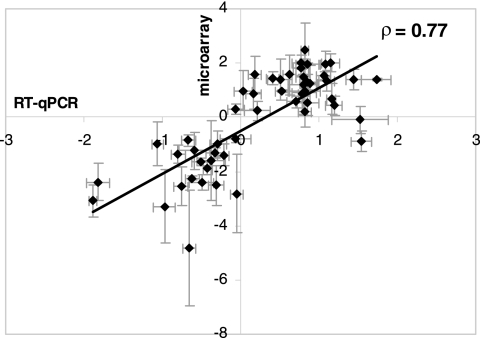The iron stimulon of Xylella fastidiosa includes genes for type IV pilus and colicin V-like bacteriocins.
Xylella fastidiosa is the etiologic agent of a wide range of plant diseases, including citrus variegated chlorosis (CVC), a major threat to citrus industry. The genomes of several strains of this phytopathogen were completely sequenced, enabling large-scale functional studies. DNA microarrays representing 2,608 (91.6%) coding sequences (CDS) of X. fastidiosa CVC strain 9a5c were used to investigate transcript levels during growth with different iron availabilities. When treated with the iron chelator 2,2'-dipyridyl, 193 CDS were considered up-regulated and 216 were considered down-regulated. Upon incubation with 100 microM ferric pyrophosphate, 218 and 256 CDS were considered up- and down-regulated, respectively. Differential expression for a subset of 44 CDS was further evaluated by reverse transcription-quantitative PCR. Several CDS involved with regulatory functions, pathogenicity, and cell structure were modulated under both conditions assayed, suggesting that major changes in cell architecture and metabolism occur when X. fastidiosa cells are exposed to extreme variations in iron concentration. Interestingly, the modulated CDS include those related to colicin V-like bacteriocin synthesis and secretion and to functions of pili/fimbriae. We also investigated the contribution of the ferric uptake regulator Fur to the iron stimulon of X. fastidiosa. The promoter regions of the strain 9a5c genome were screened for putative Fur boxes, and candidates were analyzed by electrophoretic mobility shift assays. Taken together, our data support the hypothesis that Fur is not solely responsible for the modulation of the iron stimulon of X. fastidiosa, and they present novel evidence for iron regulation of pathogenicity determinants.
Authors
Paulo A Zaini; Andréa C Fogaça; Fernanda G N Lupo; Helder I Nakaya; Ricardo Z N Vêncio; Aline M da Silva
External link
Publication Year
Publication Journal
Associeted Project
Life Sciences
Lista de serviços
-
Genomic analyses reveal broad impact of miR-137 on genes associated with malignant transformation and neuronal differentiation in glioblastoma cells.Genomic analyses reveal broad impact of miR-137 on genes associated with malignant transformation and neuronal differentiation in glioblastoma cells.
-
RNA-Binding Protein Musashi1 Is a Central Regulator of Adhesion Pathways in Glioblastoma.RNA-Binding Protein Musashi1 Is a Central Regulator of Adhesion Pathways in Glioblastoma.
-
MicroRNA Transcriptome Profiling in Heart of Trypanosoma cruzi-Infected Mice: Parasitological and Cardiological Outcomes.MicroRNA Transcriptome Profiling in Heart of Trypanosoma cruzi-Infected Mice: Parasitological and Cardiological Outcomes.
-
Genome mapping and expression analyses of human intronic noncoding RNAs reveal tissue-specific patterns and enrichment in genes related to regulation of transcription.Genome mapping and expression analyses of human intronic noncoding RNAs reveal tissue-specific patterns and enrichment in genes related to regulation of transcription.
-
Antimicrobial peptide LL-37 participates in the transcriptional regulation of melanoma cells.Antimicrobial peptide LL-37 participates in the transcriptional regulation of melanoma cells.
-
Down-regulation of 14q32-encoded miRNAs and tumor suppressor role for miR-654-3p in papillary thyroid cancer.Down-regulation of 14q32-encoded miRNAs and tumor suppressor role for miR-654-3p in papillary thyroid cancer.
-
Integration of miRNA and gene expression profiles suggest a role for miRNAs in the pathobiological processes of acute Trypanosoma cruzi infection.Integration of miRNA and gene expression profiles suggest a role for miRNAs in the pathobiological processes of acute Trypanosoma cruzi infection.
-
Integrative Biology Approaches Applied to Human DiseasesIntegrative Biology Approaches Applied to Human Diseases
-
Proteomics reveals disturbances in the immune response and energy metabolism of monocytes from patients with septic shock.Proteomics reveals disturbances in the immune response and energy metabolism of monocytes from patients with septic shock.
-
Genomics, epigenomics and pharmacogenomics of Familial Hypercholesterolemia (FHBGEP): A study protocol.Genomics, epigenomics and pharmacogenomics of Familial Hypercholesterolemia (FHBGEP): A study protocol.
-
Melatonin-Index as a biomarker for predicting the distribution of presymptomatic and asymptomatic SARS-CoV-2 carriersMelatonin-Index as a biomarker for predicting the distribution of presymptomatic and asymptomatic SARS-CoV-2 carriers
-
Profiling plasma-extracellular vesicle proteins and microRNAs in diabetes onset in middle-aged male participants in the ELSA-Brasil study.Profiling plasma-extracellular vesicle proteins and microRNAs in diabetes onset in middle-aged male participants in the ELSA-Brasil study.
-
Big Data and machine learning in cancer theranosticsBig Data and machine learning in cancer theranostics
-
Genomic positional conservation identifies topological anchor point RNAs linked to developmental loci.Genomic positional conservation identifies topological anchor point RNAs linked to developmental loci.
-
Integrative systems immunology uncovers molecular networks of the cell cycle that stratify COVID-19 severityIntegrative systems immunology uncovers molecular networks of the cell cycle that stratify COVID-19 severity

